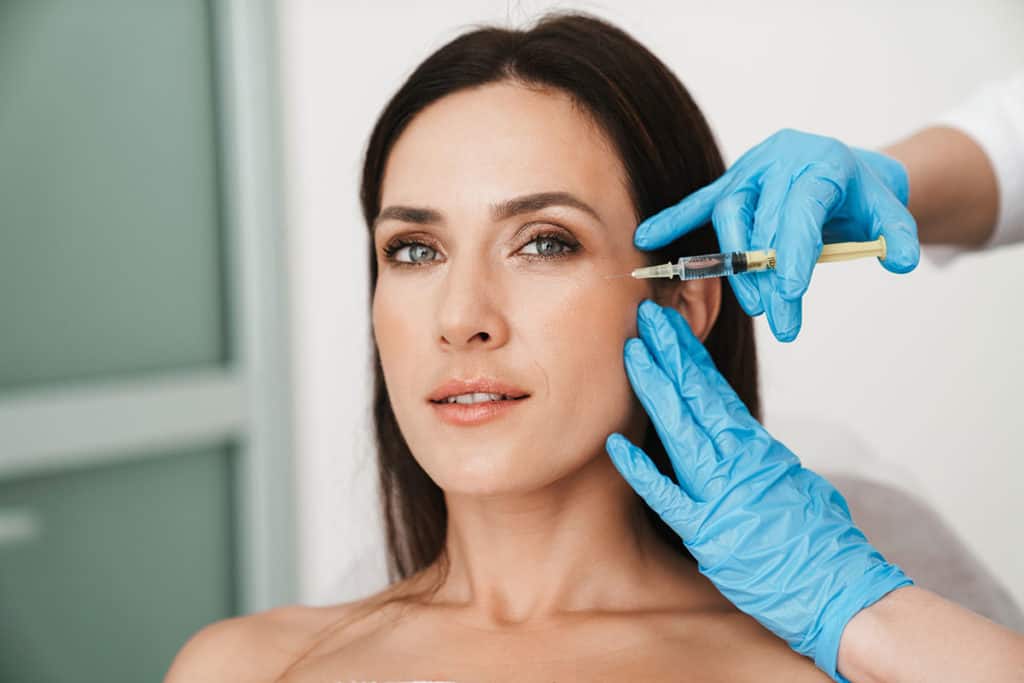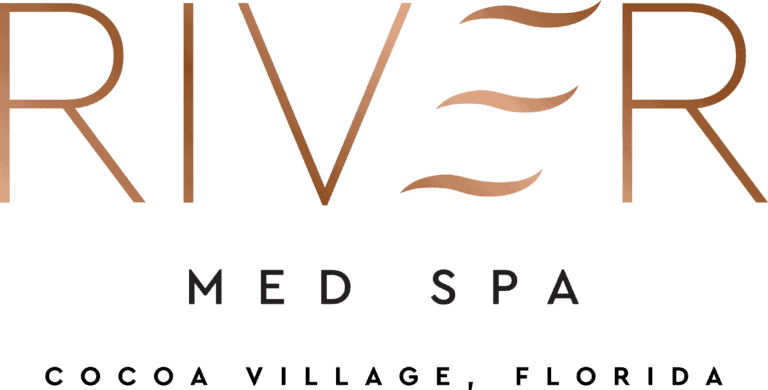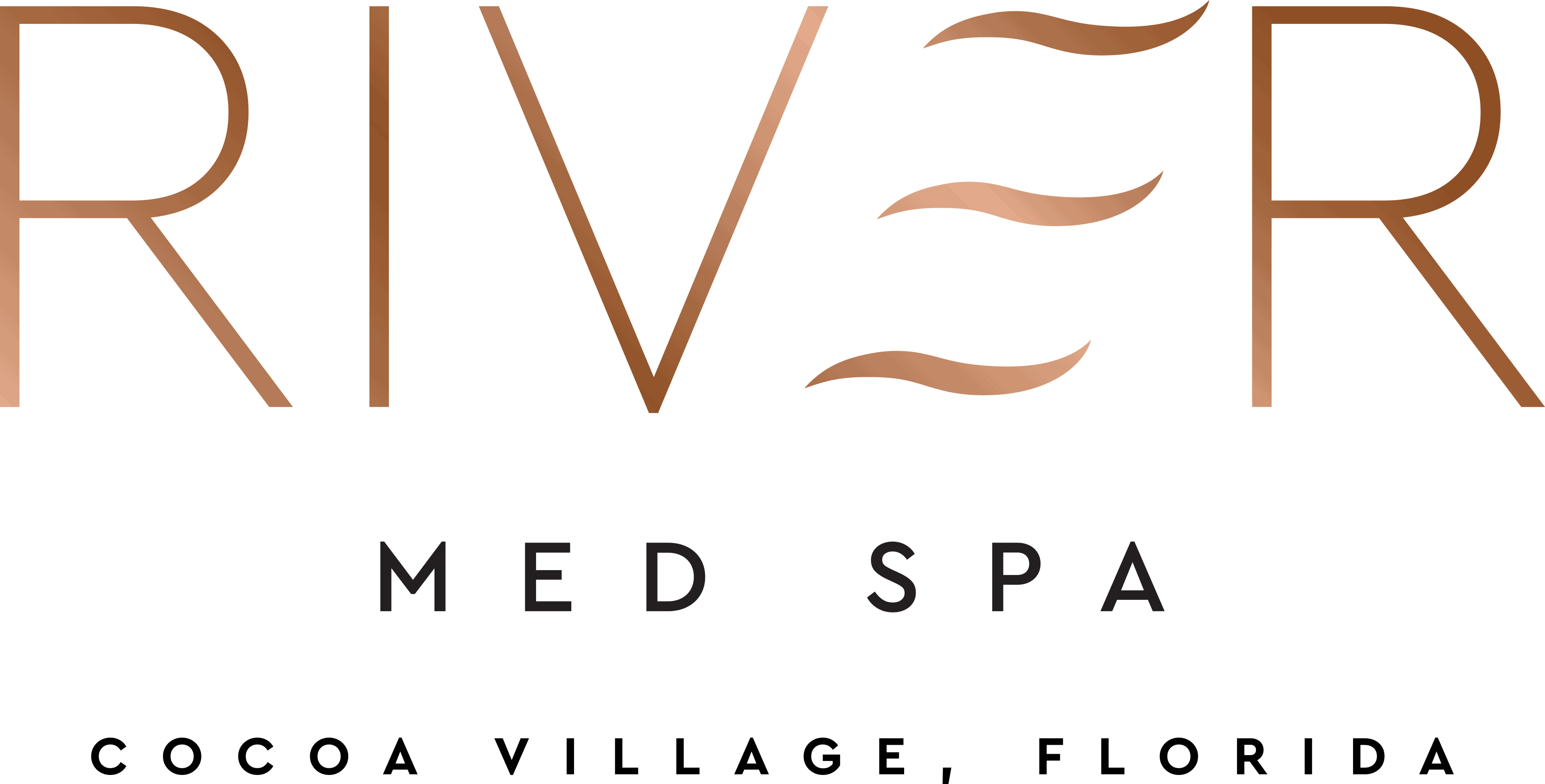What are Botox®, Daxxify, Dysport®, Jeuveau®, and Xeomin®? or more broadly, what are cosmetic neuromodulators?
Each of the four US FDA-approved cosmetic neurotoxins inhibits the action of nerves that stimulate the muscle; effectively turning off the nerves’ signal for muscle contraction. While muscles typically move bones (i.e. the legs, arms & jaw) in the face there are many muscles that function to move soft tissue such as the forehead, lips, and eyes. With time the force applied to these tissues will cause rhytids (wrinkles). Cosmetic Neurotoxins can (1) dramatically reduce rhytids, (2) can be used to elevate the eyebrows, improve smiles & smooth the neck, and (3) be effective for the management of functional medical problems.

Forehead Lines
Forehead wrinkles are a common concern of many, especially with age. Botox®, Xeomin®, Jeuveau®, and Dysport® can do wonders to soften these lines by restoring your natural smoothness and youthfulness! We often achieve a more natural result by injecting Botox or Dysport to scowl lines in the forehead. By doing so we’re preventing any new wrinkles from forming or even smoothing out the existing ones.
Scowl Lines
Keep those “11” lines a thing of the past. Botox and Dysport injections are an effective non-surgical and easy solution to smooth out those furrowed brows. FDA-approved treatments for lines or wrinkles can help create a more youthful appearance, a quick treatment can help you look rested and revitalized. Schedule an appointment with one of our qualified providers who can help you find the best treatment for your needs.
Bunny Lines
Brow Lift
Crows Feet
Lip Lines / Lip Flip
Neurotoxins can markedly reduce those bothersome fine lines surrounding your smile. Another option is a Lip Flip. A Lip Flip uses neurotoxins at the lip border to create a fuller appearance without fillers. Simple, quick, and less costly than fillers.
Dimpled Chin
Platysma
(Vertical Neck Cords)
Hyperhidrosis (Excessive Sweating)
Masseter (TMJ) / Face slimming
Headache/ Migraine Relief
Other
FAQ
Rhytid Treatments
Forehead wrinkles (frontalis muscle)
Frown/Scowl lines (Procerus & Corrugator muscles)
Crows Feet (Obicularis oculi)
Smokers Lines (Obicularis oris)
Dimpled chin (Mentalis)
Bunny lines (Nasalis)
Marionette Lines (Depressor Anguli Oris muscle)
Reshaping:
Eyebrow lift (Obicularis oculi)
Down-turned smile (Depressor Anguli Oris muscle)
Gummy smile (Levator Labii Superioris Alaeque Nasi muscle)
Platysma Bands (Platysma muscle)
Functional Treatments:
Bruxism (masseter muscle)
Migraine headaches (Frontalis, Corrugator, Procerus, Temporalis, Occipitalis, Trapezius, Cervical paraspinal muscles)
Actually, they are all very similar. They all treat and prevent fine lines, wrinkles, and deep facial furrows. Each works to reduce the muscle activity responsible for creating wrinkles and fine lines.
Xeomin is the smallest molecule and, therefore, is considered the purist neurotoxin; it is felt that the smaller molecular size may reduce the incidence of antibody-deactivation.
Daxxify is the newest neurotoxin on the market; it provides a longer duration of action — approximately six months.
Neurotoxins typically last for three to four months. To maintain a wrinkle-free appearance and prevent wrinkles from developing it is best to have regular touch-up treatments.
Preventative Botox is a proactive cosmetic treatment designed to halt the emergence of dynamic fine lines and deep creases before they become visible. Since receiving FDA approval for cosmetic use in 2002, Botox® has rapidly ascended to become the most popular non-invasive cosmetic procedure in the United States. An increasing number of patients are turning to preventative anti-aging treatments, with Preventative Botox emerging as one of the most sought-after options. This approach is particularly targeted at younger individuals, using a milder form known as “baby Botox” to subtly ward off wrinkles and signs of aging.
Botox stands out for its remarkable efficacy, minimal side effects, and minimal downtime, solidifying its position as a top choice in cosmetic procedures. The term “Botox” is often used interchangeably with neurotoxin and neuromodulator. The active component, botulinum toxin, interrupts nerve-muscle communication, effectively “freezing” the muscles to prevent them from contracting. This preventive measure aims to stop dynamic lines from becoming permanent etched wrinkles. Administering Botox before these lines become visible helps maintain a natural, youthful appearance.
What is Preventative Botox?
Preventative Botox involves early Botox treatments to avert the formation of wrinkles, such as forehead lines and frown lines. Botox, a neurotoxin, is injected to inhibit nerve signals to specific facial muscles, thereby reducing the development of dynamic fine lines which, over time, can become static and permanent. By minimizing muscle contractions associated with facial expressions, Preventative Botox fosters smoother skin texture and a youthful appearance. Dr. Green advocates a “less-is-more” philosophy, employing a conservative approach to ensure natural-looking results. The effects typically last up to four months, and many patients opt for regular maintenance to sustain optimal results.
The rise of Preventative Botox can be attributed in part to its increasing visibility on social media. Young men and women are increasingly seeking Botox treatments, influenced by celebrities and influencers who openly share their cosmetic experiences. This has led to a surge in “baby Botox,” where smaller amounts are used to achieve a more subtle effect while preserving natural muscle movement.
When to Start Preventative Botox
As skin ages, it loses collagen and elastin—key proteins responsible for its firmness and elasticity. Factors such as sun exposure, environmental stress, and genetics contribute to the gradual loss of these proteins, making dynamic lines more likely to become permanent. Preventative Botox is becoming a common choice for individuals in their mid-to-late 20s and early 30s, who seek to forestall the onset of deep wrinkles and creases. We liken this preventive approach to smoothing out creases in paper before they become permanent.
If you are considering whether to start Botox treatments, look for early signs such as visible fine lines or wrinkles that become etched into the skin even when not actively making facial expressions. Preventative Botox can act as an early intervention to stave off these signs of aging, akin to incorporating sunscreen into your daily skincare regimen.
How Preventative Botox Works
Botox is most effective in preventing dynamic wrinkles and the formation of deeper lines. These wrinkles, caused by repetitive facial expressions, include crow’s feet, glabellar lines, and forehead lines. Over time, these lines can become ingrained in the skin due to decreased collagen production. Preventative Botox works by “freezing” targeted facial muscles to prevent contractions that lead to these wrinkles. The treatment involves injecting botulinum toxin A into specific muscles, blocking nerve signals and thereby preventing muscle activation. While Botox can smooth out existing wrinkles, its primary benefit in younger patients is to prevent the formation of new lines.
The Process of Preventative Botox Injections
During your initial consultation, your medical history, previous cosmetic procedures, and specific aesthetic goals will be reviewed to create a tailored treatment plan. If deemed appropriate, the Botox treatment can often be administered on the same day. The injections are minimally invasive, typically using a tiny needle, and may involve the application of a topical numbing cream for added comfort. After treatment, ice packs are applied to minimize swelling. You will receive aftercare instructions, including avoiding strenuous exercise for 24 hours. The full effects become apparent within a week, and follow-up evaluations are recommended to ensure satisfaction and optimal results.
Is Botox Preventative for Wrinkles?
Absolutely. Botox is effective in preventing the development of permanent wrinkles. By blocking nerve signals and preventing muscle contractions, Botox can stop dynamic wrinkles from becoming static, etched lines. This preventative approach ensures that wrinkles do not form in the first place, maintaining smoother skin over time.
Frequency and Areas for Preventative Botox
Preventative Botox typically lasts between 3 to 4 months, with some patients experiencing results for up to six months. The frequency of treatments depends on individual metabolism and the amount of Botox used. Most patients schedule treatments every four months. Common areas for preventative Botox include the forehead, glabella (between the eyebrows), and crow’s feet around the eyes. Dr. Green will customize the treatment plan based on your unique facial structure and aesthetic goals.
Combining Preventative Botox with Other Treatments
Preventative Botox can be effectively combined with other cosmetic treatments such as dermal fillers, laser treatments, and chemical peels. Dermal fillers like Juvederm®, Restylane®, Belotero®, and Sculptra® can complement Botox by addressing volume loss and other signs of aging. This combination approach, often referred to as a “liquid facelift,” provides comprehensive facial rejuvenation.
Cost and Side Effects
The cost of Preventative Botox varies based on factors such as the number of units used, geographic location, and the experience of the injector. Board-certified physicians typically offer higher expertise, which may reflect in the cost. Potential side effects are usually minimal, including mild swelling or bruising. Rare but serious side effects require immediate medical attention and include muscle weakness, difficulty breathing, and vision problems.
Conclusion
Preventative Botox is a proactive strategy to maintain a youthful appearance by preventing the formation of wrinkles before they become permanent. It’s a popular choice for younger individuals seeking to preserve smooth, youthful skin and can be combined with other cosmetic treatments for a comprehensive rejuvenation approach. For personalized advice and treatment, consult with a board-certified dermatologist to determine the best approach for your cosmetic goals.
You can not be pregnant or breastfeeding. It is best to avoid anti-inflammatories (including aspirin) taken on an as-needed basis; however, do not discontinue medically prescribed treatments!

